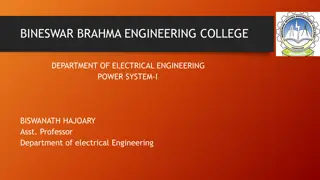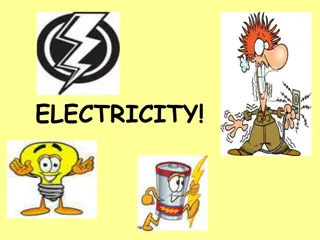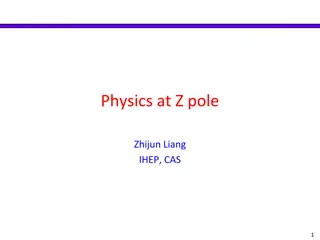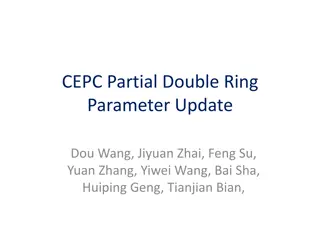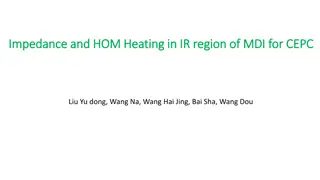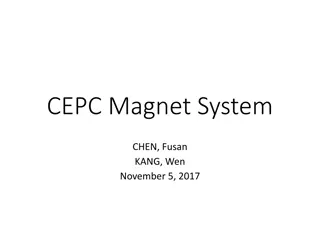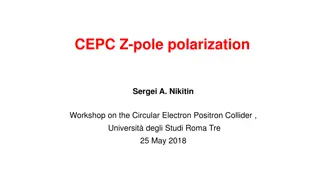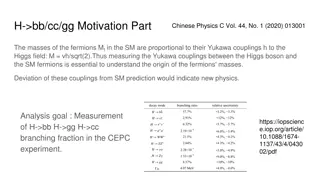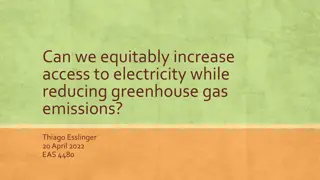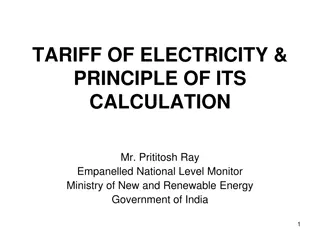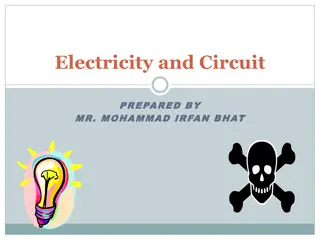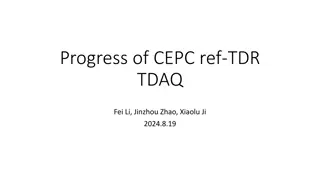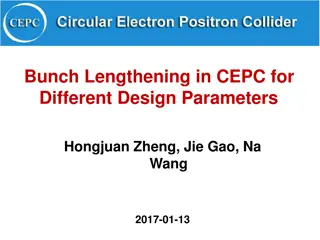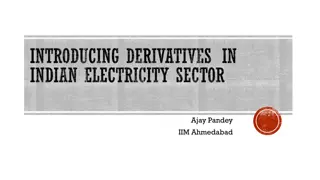Comparison of Electricity Power Systems Between CEPC and FCCee
The evaluation and comparison of electricity power systems between the CEPC and FCCee accelerators reveal the power breakdowns, RF power consumption, magnet power supply, and overall power usage. Differences in power consumption for various components such as RF, magnets, and vacuum systems are highlighted, with a focus on the collider SRF power consumption. CEPC is shown to consume 12 MW more than FCCee in the collider SRF system due to differences in klystron efficiency and LLRF control.
Download Presentation

Please find below an Image/Link to download the presentation.
The content on the website is provided AS IS for your information and personal use only. It may not be sold, licensed, or shared on other websites without obtaining consent from the author. Download presentation by click this link. If you encounter any issues during the download, it is possible that the publisher has removed the file from their server.
E N D
Presentation Transcript
CEPC Day 25. November. 2022 Electricity Power Evaluation and Comparison with FCCee Yuhui Li On behalf of CEPC accelerator team 1
CEPC & FCCee power @ eeFACT meeting Update of FCC-ee power demand CECP TDR 50MW power breakdowns @ HIGGS Z W 80 44% 66% 100% 19% 43% 100% 146 146 2 2 12,6 15,8 47,5 34 36 17 39 3 5 8 8 4 4 H TT Beam energy (GeV) Magnet current Power ratio PRF EL (MW) PRFb EL (MW) Pcryo (MW) Pcv (MW) PEL magnets (MW) Stroage PEL magnets (MW) Booster Experiments (MW) Pt A & G Data centers (MW) Pt A & G General services (MW) 45.6 25% 6% 146 2 1,3 33 6 1 8 4 120 182.5 Storage Booster all all 146 2 40.2 89 11 8 4 CEPC power is 50 MW higher than FCCee @ higgs (341 v.s. 291 MW) Difference of power consumption not clear: RF power Magnet Vacuum Cryogenics power is similar: ~17.9MW v.s. 15.8MW Auxiliary power: FCC: Cooling & Ventilation (36)+Experiment (8)+Data center (4)+General Service (36) =84MW CEPC: Instrumentation(2.2)+Radiation Protection(0.4) +Control(1.8)+Experimental device(4)+Utility(49.7)+General Service(19.8) = 78 MW 36 36 36 36 Power during beam operation (MW) Average power / year (MW) 237 262 291 384 143 157 173 224 RF power: 174MW v.s. 148MW Magnet power: 63.5MW v.s. 44MW Re-evaluate RF & Magnet power for CEPC 2
Content Collider SRF power consumption Magnet (Dipole, quadrupole, Sextupole) power Magnet power supply Vacuum Booster SRF power consumption Magnet (Dipole, quadrupole) power Magnet power supply Vacuum Linac RF power consumption 30GeV linac power (Gun, SHBs Solid State Amplifier, LLRF, ) Magnet & Power supply Vacuum 3
General Comparison between CEPC and FCCee electric Power Machine System CEPC FCCee RF Power (MW) 158 146 Magnet (MW) 44.5 38.6 Collider Vacuum (MW) 5.38 - Total (MW) 207.88 184.6 RF Power (MW) 1.4 2.0 Magnet (MW) 9.83 5.0 Booster Vacuum (MW) 4.22 - Total (MW) 15.45 7.0 RF Power (MW) 13.6 10.0 Microwave(MW) 0.539 - Magnet 3.61 - Linac Vacuum (MW) 0.64 - Total (MW) 18.39 10.0 Power Sum (MW) 241.72 201.6 4
Collider: SRF power consumption Wall to modulator (C1), modulator to klystron (C2), klystron efficiency (C3), waveguide to coupler (C4) ,LLRF control (C5) Overall efficiency= C1* C2*C3*C4 Electricity Power = Beam Power*C5 / overall efficiency Both CEPC and FCCee assumes 100MW beam power (e/e+ beam 50MW) CEPC consumes 12 MW more than FCCee in the collider SRF system. The major differences come from klystron efficiency and LLRF control 5
Collider: Magnet power Power ratio= (operation energy/180GeV)^2 Magnet power = power @ ttbar * power ratio Total mag. Loss = Dipole+QUAD+Sextupole+Corrector+Cable Electricity Power = total mag. Loss / (0.9*0.95) --- wall to plug, power supply efficiency At HIGGS, CEPC consumes 5.9 MW more than FCCee in the collider magnet system. Detail information seeing next pages. 6
Collider: CEPC & FCC Magnet Power Comparison @ tt CECP consumes 9.5MW more power than FCCee at ttbar operation CEPC aperture is smaller; CEPC counts magnets in the arc and other regions, while FCC only counts arc mag FCC uses Cu for quadrupole and sextupole, CEPC use Al for quadrupole 7
Collider: Vacuum System There is no FCC data report 5.38, 9.90, 9.90 MW are consumed for HIGG, Z and W operation, respectively 8
Booster: SRF Power energy transfer rate from wall to Solid State Amplifier, SSA, (C1), SSA number (C2), Duty factor (C3), SSA Efficiency (C4) and LLRF control (C5). Electricity Power = Operation pulsed power *C5*C3*C2/C1/C4 CEPC booster SRF system consumes 0.6 MW less power than FCC 9
Booster: Magnet Power Power ratio= (operation energy/180GeV)^2 Magnet power = power @ ttbar * power ratio Total mag. Loss = (Dipole+QUAD+Sextupole+Corrector+Cable) * duty factor Electricity Power = total mag. Loss / (0.9*0.95) --- wall to plug, power supply efficiency At HIGGS, CEPC consumes 4.83 MW more than FCCee in the Booster magnet system. CEPC duty cycle is 47%, while FCC is 15% CEPC needs no sextupole and cable power is 3.5 MW lower than FCC 10
Booster: Vacuum System There is no FCC data report 4.22 MW is consumed for HIGG, Z and W operation 11
Linac (30GeV): RF system wall to modulator (C1), modulator efficiency (C2), klystron efficiency (C3), S-band klystron number (C4) S-band duty factor (C5), C-band klystron number (C6), C-band duty factor (C7). Electricity Power = (S_band operation pulsed power*C4*C5+C_band operation pulsed power*C6*C7) /C1/C2/C3 CEPC consumes 3.6 MW more than FCCee in the Linac RF system Lack of details for FCC 12
Linac (30GeV): Microwave system There is no FCC data report 13
Linac (30GeV): Magnet system Total mag. Loss = Dipole+QUAD+Solenoids+Cable Electricity Power = total mag. Loss / (0.9*0.95) --- wall to plug, power supply efficiency There is no FCC data report 14
Part III Booster Technology: SRF, RF Power Source, Magnets There is no FCC data report 0.64 MW is consumed 15
Summary Machine System CEPC FCCee RF Power (MW) 158 146 Magnet (MW) 44.5 38.6 Collider Vacuum (MW) 5.38 - The power of RF and magnet systems are carefully re- evaluated; The calculation equations are given; The updated power is similar to it presented at eeFACT (244MW v.s. 242MW), but with different contributions; CEPC consumes 40MW power than FCC in RF and magnet system; The difference is due to the missing items that FCC has not count: Magnets in straight session/linac, vacuum system, LLRF, klystron efficiency (75% vs 80%) Collider quadrupole material (Al vs Cu) CEPC has higher duty factor than FCC in the booster; Total (MW) 207.88 184.6 RF Power (MW) 1.4 2.0 Magnet (MW) 9.83 5.0 Booster Vacuum (MW) 4.22 - Total (MW) 15.45 7.0 RF Power (MW) 13.6 10.0 Microwave(MW) 0.539 - Magnet 3.61 - Linac Vacuum (MW) 0.64 - Total (MW) 18.39 10.0 Power Sum (MW) 241.72 201.6 16
The End 17
Collider: Magnet Power calculation example CEPC @ Higgs Total Power = Dipole + Quadrupole + Sextupole + Corrector Magnet-type power = quantity * single mag. Power Single mag. Power depends on Maximum gradient, aperture and conductor material No data is reported for FCCee Higgs, and it can be scaled from ttbar data 18
The End 19





